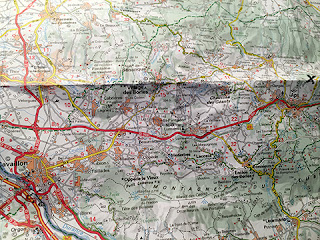I might have been in France for the food or the art and culture, but Sweetie was interested in the Roman influence.
In 123
BC the Romans founded Aix-en-Provence, and two years
later began improvements at Nemausa (today Nimes.) We visited Aix and soon would learn a lot about the Romans in Nimes at the Pont du Gard.
As we left St. Saturnin-les-Apt and drove towards Avignon, we were leaving the
eastern area of Provence that had been pacified by the Romans and heading
towards the western area of that same province, which historically extended all the way to Nimes and the
Gard river.
Apt, just below St. Saturnin-les-Apt had been a major Roman
settlement for retired Roman legionnaires and also one of the places on the Via
Domitia, a major Roman road built in 118 BC. This road was partly for commerce,
but also part of the Roman defense system because it went from the easiest
crossing point of the Alps, through Sisteron, Apt, and Cavaillon to Tarascon.
Our route to Avignon took us along this same way as far as Cavaillon,(first photo below from "X" at right to Cavaillon on left) but then
we turned northwest to Avignon (second photo below from Cavaillon on right to Avignon at left).
The Pax Romana, or Roman Peace, in Provence
lasted for nearly three centuries. During this period, all of Provence, from
the Alps to the Pyrenees had for the first time the same language,
administration, currency and culture. Residents of Provence felt secure enough
to give up their fortified hilltop towns (like St. Saturnin-les-Apt and
Roussillon) and move down into the plains to towns like Avignon. As Pliny
wrote, "it was more than a province, it was another Italy." During
that time the citizens grew used to abundance in the markets due to Roman
trading and good roads, there was often abundant water from aqueducts, and the
Romans built huge public works like public baths, theatres and stadiums, and
temples.
The Pax Romana in Provence lasted until the middle of
the 3rd century. Germanic tribes
invaded Provence in 257 and 275. At the beginning the 4th century, the court of
Roman Emperor Constantine (280-337) was forced to take refuge in Arles. By the
end of the 5th century, Roman power in Provence had vanished, and an age of
invasions, wars, and chaos began. People returned to the hill towns for
protection and new walls were built. Because
of the repeated invasions, Provençal architecture was designed to resist
attack. Monasteries were surrounded by towers and walls, and even the bishop's
residence in Frejus resembled a fortress. Castles on hilltops surrounded by
walled towns became the characteristic architectural feature of Provence. Only
in the 17th century, after the wars of religion had ended and the French king
had established his authority, were the towns of Provence safe from outside
attack.
Some towns like Lourmarin have later chateaus that likely were built during relative peace since the chateau has protective walls, but the town itself seemed like it was not too worried about walls and protection.
Here and there you can still find remnants of Roman
civilization in Provence. The multitude of fountains in Aix is an example of
the influence of the Roman ideal of using flowing water as a design element and
to keep the town clean and to provide water for drinking and bathing. One of the places we wanted to visit, using Avignon as
a base, was the Pont du Gard, one of the best examples of Roman aqueduct
building still standing. The water it carries went to Nimes in the far western
section of Provence.
Nemausus (which became Nimes) was the
capital of the Volcae Arecomici before the Roman conquest. In 118 the area
came under Roman influence as the Via Domitia brought more Romans to the area. Nimes
was primarily a veterans colony in 28 BC. At its peak it has been estimated
that the population was around 50,000 people. The aqueduct, part of which is
seen at the Pont du Gard, was built during the second half of the first century and
it brought clean water to the city. The Romans had been using aqueducts to bring water to their cities since 313
BC or longer. The Roman aqueduct has
been preferred to any other plan for conveying water in large quantities a
considerable distance, over great inequalities of ground, for a long time.
Water brought to a city was divided and the public uses included ponds and fountains, amphitheatres, baths, and military camps.
Public baths and fountains were a distinctive feature of Roman civilization. The rest went to the general public for private use.
Water brought to a city was divided and the public uses included ponds and fountains, amphitheatres, baths, and military camps.
Public baths and fountains were a distinctive feature of Roman civilization. The rest went to the general public for private use.
This Roman influence in Provence might not be of extreme interest to you, but it was one of the reasons that we decided to spend a few days in Avignon.


















No comments :
Post a Comment